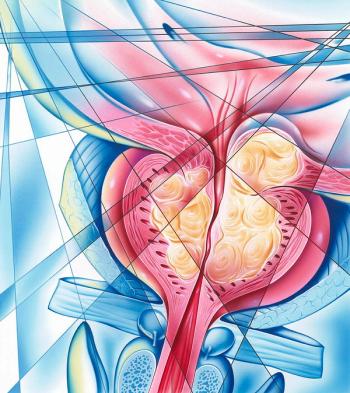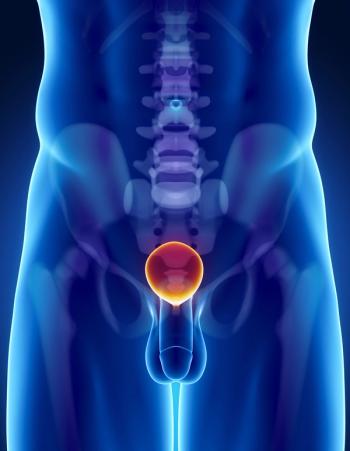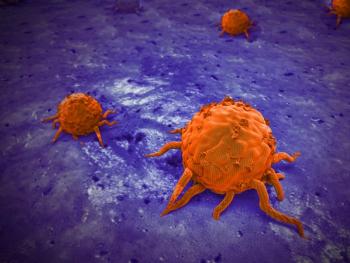
- ONCOLOGY Vol 10 No 7
- Volume 10
- Issue 7
Combinations of Hormones and Local Therapies in Locally Advanced Prostate Carcinoma
Until recently, newly diagnosed patients with prostate cancer were faced with one of four basic management options: observation, radiation therapy, radical prostatectomy, or hormonal manipulation. The exact option chosen by an individual
Until recently, newly diagnosed patients with prostate cancerwere faced with one of four basic management options: observation,radiation therapy, radical prostatectomy, or hormonal manipulation.The exact option chosen by an individual patient depended on hissymptoms and life expectancy, stage of disease, and (for organ-confinedcancers) degree of tumor differentiation. In more recent years,combinations of therapies have been examined more extensively.These trials are now reaching a maturity sufficient for preliminaryevaluation.
The review by Eulau and Corn addresses treatment options for patientswith locally advanced prostate cancer. Their review places emphasison data derived from clinical trials using hormonal therapy incombination with radiation or surgery.
Staging, End Point, and Patient Selection Issues
Patients with locally advanced prostate cancer are an extremelyheterogeneous group within a disease known for its heterogeneity.The extent and manner of staging are critical for the accuratedetermination of prognosis. When patients with clinical stageC (T3,NX,M0) disease undergo a pelvic lymph node dissection, approximately50% are found to have pathologic stage D1 (TX,N1,M0) disease [1].If immunohistochemical stains or molecular-based pathologic methodswere routinely used, node-positive disease would be detected evenmore frequently. Thus, when evaluating treatment efficacy, itis essential to realize that 50% of patients with clinical stageC disease actually have early-stage metastatic cancer and thatpoor long-term outcomes can be expected for the majority of thesepatients if treated with radiation or surgery only.
As with any clinical trials, comparisons of nonrandomized studiesin prostate cancer are difficult. Trials with distinct end pointsmay or may not be comparable; ie, trials evaluating outcomes basedon prostate-specific antigen (PSA) are very different from trialsevaluating clinical-based outcomes. In addition, patient selectioncan have a profound influence on outcome. Protocols conductedat the Mayo Clinic, for example, cannot readily be compared tothose conducted at Charity Hospital in New Orleans. When takentogether, issues related to staging, end points, and patient selectionconspire to make comparisons of nonrandomized trials extremelydifficult.
Given these facts, evidence for treatment efficacy can best bederived from adequately powered, prospective, multicenter randomizedtrials with clearly defined, clinically relevant end points. Withthis guiding dictum, a review of locally advanced prostate cancerprotocols is vastly simplified.
The RTOG Trials
The studies meeting these criteria in locally advanced prostatecancer have been conducted under the auspices of the RTOG or theEORTC Radiotherapy Therapy and Genitourinary Tract Cancer CooperativeGroups. To these organizations' credit, these trials are wellexecuted and appropriately analyzed.
What data are available and sufficiently mature to analyze? Theend points cited in most trials include locoregional control andprogression-free survival. When these end points are used, severalrandomized trials suggest that the combination of hormones andradiation is more effective than radiation alone for clinicallystaged locally advanced prostate cancer. In particular, RTOG trials85-31 and 86-10 demonstrate that adjuvant goserelin (Zoladex)or neoadjuvant goserelin plus flutamide (Eulexin) can decreaselocal relapse rates and increase progression-free survival rates.Based on data from the excellently executed RTOG 86-10 trial [2],the addition of approximately 4 months of goserelin plus flutamideto external-beam radiation therapy can increase the 5-year progression-freesurvival rate from 15% to 36% (P less than .001). A significantdecrease in the rate of local progression (from 71% to 46%, Pless than .001) was also noted with combination therapy.
Much will be learned from continued follow-up of patients treatedin the randomized RTOG trials. Will there be survival advantages?Will the survival curves plateau? Will prior hormonal therapydecrease the duration of response to subsequent hormonal therapy?
Results from the EORTC study have not yet been published in thepeer-reviewed literature, but preliminary results presented atthe American Society of Clinical Oncology's 1996 meeting are particularlynoteworthy [3]. In this trial, patients with high-grade T1-T2tumors or any-grade T3-T4 tumors (and no known nodal or distantmetastases) were randomized to receive radiation alone or radiationplus 3 years of hormonal therapy. The hormonal therapy startedat the beginning of radiation and consisted of 3 years of goserelininjections. One month of an antiandrogen (cyproterone acetate)was also administered during the first month of therapy. Medianfollow-up was only 33 months. However, estimated overall 5-yearsurvival in patients receiving combined hormonal and radiationtherapy was 78%, as compared with 56% for those receiving radiationalone (P = .001). Local control was achieved in 95% of those treatedwith combined therapy and 75% of those given radiation alone (Pless than .001).
These preliminary data are extremely impressive and are the firstto indicate that an overall survival advantage may be conferredby the combinations of hormones and radiation in patients withlocally advanced prostate cancer. The peer-reviewed publicationof these important data and additional reports concerning analysisof more mature data are eagerly anticipated.
Trials of Neoadjuvant Hormonal Therapy
The review by Eulau and Corn also covers randomized trials ofneoadjuvant hormonal therapy prior to radical prostatectomy. Thesetrials are not of sufficient maturity to make clinically relevantconclusions. In the preliminary analyses, the addition of hormonaltherapy favorably influences pathologic, but not clinical, endpoints. More mature data from these studies are eagerly anticipated.
Importance of the RTOG Data
In the absence of any conflicting data, the RTOG and the EORTCstudies assume even more importance. For patients with clinicallystaged locally advanced prostate cancer, these data provide hopethat combinations of hormonal and radiation therapy will providebetter disease control than radiation therapy alone. In fact,according to Eulau and Corn, the RTOG has accepted a combinationof radiation and maximal androgen blockade as standard treatmentfor future trials, and the FDA recently granted approval for thetreatment of stage B2/C prostate cancer with flutamide in combinationwith a luteinzing hormone-releasing hormone (LHRH) agonist andradiation. If the EORTC trial's survival data continue to holdtrue with additional follow-up, combinations of radiation andhormonal therapy should be regarded as the standard of therapyfor patients with locally advance prostate cancer for many yearsto come.
Much progress is still needed for patients with locally advancedprostate cancer. The optimal timing and extent of hormonal therapyhas yet to be determined. In addition, no trial has assessed theutility of hormonal treatment alone for patients with locallyadvanced prostate cancer. Until such a study is performed thecontribution of radiation therapy to improved patient outcomecannot be objectively assessed. I also note that despite the bestof current treatments, a majority of patients will have progressivecancer within 5 years of treatment. Innovative approaches in combinationwith appropriately designed and adequately powered clinical trialsare needed to improve this dismal prognosis.
References:
1. Zincke H: Bilateral pelvic lymphadenectomy and radical prostatectomyfor stage C or D1 adenocarcinoma of the prostate: Possible beneficialeffect of adjuvant treatment. NCI Monogr 7:109-115, 1988.
2. Pilepich MV, Krall JM, Al-Sarraf M, et al: Androgen deprivationwith radiation therapy compared with radiation therapy alone forlocally advanced prostatic carcinoma: A randomized comparativetrial of the Radiation Therapy Oncology Group. Urology 45:616-623,1995.
3. Bolla M, Gonzalez D, Warde P, et al: Immediate hormonal therapyimproves locoregional control rates and survival in patients withlocally advanced prostate cancer. Results of a randomized phaseIII clinical trial of the EORTC radiotherapy and genitourinarytract cancer cooperative groups. Proceedings American Societyof Clinical Oncology 15:591A, 1996.
Articles in this issue
over 29 years ago
The Role of PSA in the Radiotherapy of Prostate Cancerover 29 years ago
The Role of PSA in the Radiotherapy of Prostate Cancerover 29 years ago
The Role of PSA in the Radiotherapy of Prostate Cancerover 29 years ago
State of the Art in Umbilical Cord Transplantationover 29 years ago
Viatical Bill of Rightsover 29 years ago
Hospice and Palliative Care: Program Needs and Academic Issuesover 29 years ago
Long-Term Consequences of the Breast Implant Debateover 29 years ago
Hospice and Palliative Care: Program Needs and Academic IssuesNewsletter
Stay up to date on recent advances in the multidisciplinary approach to cancer.




















































































